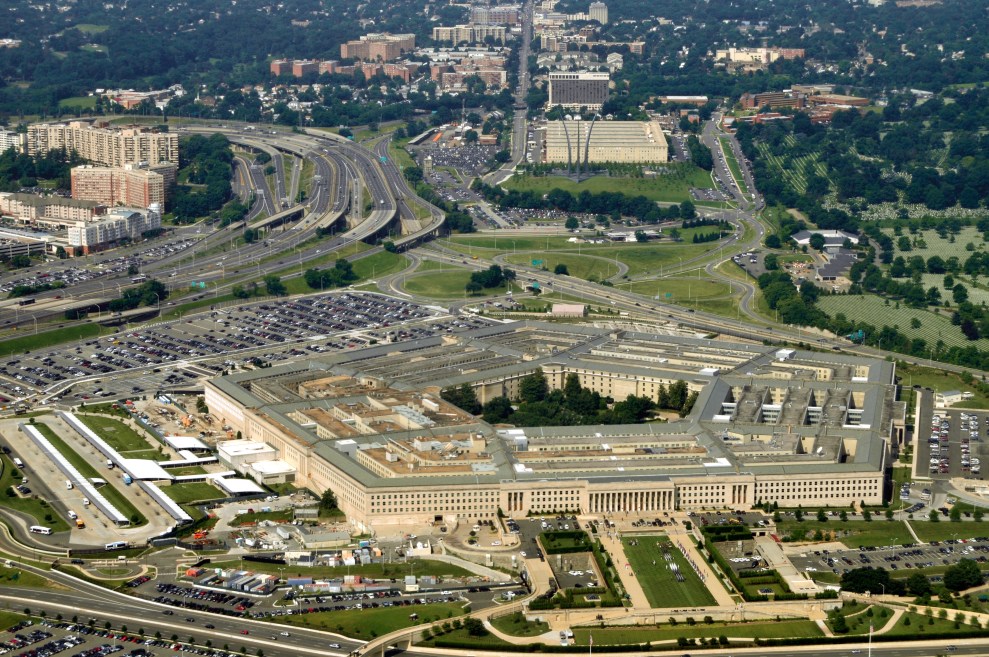
<a href="http://www.shutterstock.com/pic-35841916/stock-photo-aerial-of-the-pentagon-the-department-of-defense-headquarters-in-arlington-virginia-near.html?src=-Oax7G9FkGfRgN8Ilkb8Xg-1-27">Shutterstock</a>
This story first appeared on the TomDispatch website.
These days, lamenting the apparently aimless character of Washington’s military operations in the Greater Middle East has become conventional wisdom among administration critics of every sort. Senator John McCain thunders that “this president has no strategy to successfully reverse the tide of slaughter and mayhem” in that region. Anthony Cordesman of the Center for Strategic and International Studies bemoans the “lack of a viable and public strategy.” Andrew Bacevich suggests that “there is no strategy. None. Zilch.”
After 15 years of grinding war with no obvious end in sight, US military operations certainly deserve such obloquy. But the pundit outrage may be misplaced. Focusing on Washington rather than on distant war zones, it becomes clear that the military establishment does indeed have a strategy, a highly successful one, which is to protect and enhance its own prosperity.
Given this focus, creating and maintaining an effective fighting force becomes a secondary consideration, reflecting a relative disinterest—remarkable to outsiders—in the actual business of war, as opposed to the business of raking in dollars for the Pentagon and its industrial and political partners. A key element of the strategy involves seeding the military budget with “development” projects that require little initial outlay but which, down the line, grow irreversibly into massive, immensely profitable production contracts for our weapons-making cartels.
If this seems like a startling proposition, consider, for instance, the Air Force’s determined and unyielding efforts to jettison the A-10 Thunderbolt, widely viewed as the most effective means for supporting troops on the ground, while ardently championing the sluggish, vastly overpriced F-35 Joint Strike Fighter that, among myriad other deficiencies, cannot fly within 25 miles of a thunderstorm. No less telling is the Navy’s ongoing affection for budget-busting programs such as aircraft carriers while maintaining its traditional disdain for the unglamorous and money-poor mission of mine-sweeping, though the mere threat of enemy mines in the 1991 Gulf War (as in the Korean War decades earlier) stymied plans for major amphibious operations. Examples abound across all the services.
Meanwhile, ongoing and dramatic programs to invest vast sums in meaningless, useless, or superfluous weapons systems are the norm. There is no more striking example of this than current plans to rebuild the entire American arsenal of nuclear weapons in the coming decades, Obama’s staggering bequest to the budgets of his successors.
These nuclear initiatives have received far less attention than they deserve, perhaps because observers are generally loath to acknowledge that the Cold War and its attendant nuclear terrors, supposedly consigned to the ashcan of history a quarter-century ago, are being revived on a significant scale. The US is currently in the process of planning for the construction of a new fleet of nuclear submarines loaded with new intercontinental nuclear missiles, while simultaneously creating a new land-based intercontinental missile, a new strategic nuclear bomber, a new land-and-sea-based tactical nuclear fighter plane, a new long-range nuclear cruise missile (which, as recently as 2010, the Obama administration explicitly promised not to develop), at least three nuclear warheads that are essentially new designs, and new fuses for existing warheads. In addition, new nuclear command-and-control systems are under development for a fleet of satellites (costing up to $1 billion each) designed to make the business of fighting a nuclear war more practical and manageable.
This massive nuclear buildup, routinely promoted under the comforting rubric of “modernization,” stands in contrast to the president’s lofty public ruminations on the topic of nuclear weapons. The most recent of these was delivered during his visit—the first by an American president—to Hiroshima last month. There, he urged “nations like my own that hold nuclear stockpiles” to “have the courage to escape the logic of fear, and pursue a world without them.”
In reality, that “logic of fear” suggests that there is no way to “fight” a nuclear war, given the unforeseeable but horrific effects of these immensely destructive weapons. They serve no useful purpose beyond deterring putative opponents from using them, for which an extremely limited number would suffice. During the Berlin crisis of 1961, for example, when the Soviets possessed precisely four intercontinental nuclear missiles, White House planners seriously contemplated launching an overwhelming nuclear strike on the USSR. It was, they claimed, guaranteed to achieve “victory.” As Fred Kaplan recounts in his book Wizards of Armageddon, the plan’s advocates conceded that the Soviets might, in fact, be capable of managing a limited form of retaliation with their few missiles and bombers in which as many as three million Americans could be killed, whereupon the plan was summarily rejected.

In other words, in the Cold War as today, the idea of “nuclear war-fighting” could not survive scrutiny in a real-world context. Despite this self-evident truth, the US military has long been the pioneer in devising rationales for fighting such a war via ever more “modernized” weapons systems. Thus, when first introduced in the early 1960s, the Navy’s invulnerable Polaris-submarine-launched intercontinental missiles—entirely sufficient in themselves as a deterrent force against any potential nuclear enemy—were seen within the military as an attack on Air Force operations and budgets. The Air Force responded by conceiving and successfully selling the need for a full-scale, land-based missile force as well, one that could more precisely target enemy missiles in what was termed a “counterforce” strategy.
The drive to develop and build such systems on the irrational pretense that nuclear war fighting is a practical proposition persists today. One component of the current “modernization” plan is the proposed development of a new “dial-a-yield” version of the venerable B-61 nuclear bomb. Supposedly capable of delivering explosions of varying strength according to demand, this device will, at least theoretically, be guidable to its target with high degrees of accuracy and will also be able to burrow deep into the earth to destroy buried bunkers. The estimated bill—$11 billion—is a welcome boost for the fortunes of the Sandia and Los Alamos weapons laboratories that are developing it.
The ultimate cost of this new nuclear arsenal in its entirety is essentially unknowable. The only official estimate we have so far came from the Congressional Budget Office, which last year projected a total of $350 billion. That figure, however, takes the “modernization” program only to 2024—before, that is, most of the new systems move from development to actual production and the real bills for all of this start thudding onto taxpayers’ doormats. This year, for instance, the Navy is spending a billion and a half dollars in research and development funds on its new missile submarine, known only as the SSBN(X). Between 2025 and 2035, however, annual costs for that program are projected to run at $10 billion a year. Similar escalations are in store for the other items on the military’s impressive nuclear shopping list.
Assiduously tabulating these projections, experts at the Monterey Center for Nonproliferation Studies peg the price of the total program at a trillion dollars. In reality, though, the true bill that will come due over the next few decades will almost certainly be multiples of that. For example, the Air Force has claimed that its new B-21 strategic bombers will each cost more than $564 million (in 2010 dollars), yet resolutely refuses to release its secret internal estimates for the ultimate cost of the program.
To offer a point of comparison, the F-35 Joint Strike Fighter, the tactical nuclear bomber previously mentioned, was originally touted as costing no more than $35 million per plane. In fact, it will actually enter service with a sticker price well in excess of $200 million.
Nor does that trillion-dollar figure take into account the inevitable growth of America’s nuclear “shield.” Nowadays, the excitement and debate once generated by President Ronald Reagan’s “Star Wars” scheme to build a defense system of anti-missile missiles and other devices against a nuclear attack is long gone. (The idea for such a defense, in fact, dates back to the 1950s, but Reagan boosted it to prominence.) Nevertheless, missile defense still routinely soaks up some $10 billion of our money annually, even though it is known to have no utility whatsoever.
“We have nothing to show for it,” Tom Christie, the former director of the Pentagon’s testing office, told me recently. “None of the interceptors we currently have in silos waiting to shoot down enemy missiles have ever worked in tests.” Even so, the US is busy constructing more anti-missile bases across Eastern Europe. As our offensive nuclear programs are built up in the years to come, almost certainly eliciting a response from Russia and China, the pressure for a costly expansion of our nuclear “defenses” will surely follow.
It’s easy enough to find hypocrisy in President Obama’s mellifluous orations on abolishing nuclear weapons given the trillion-dollar-plus nuclear legacy he will leave in his wake. The record suggests, however, that faced with the undeviating strategic thinking of the military establishment and its power to turn desires into policy, he has simply proven as incapable of altering the Washington system as his predecessors in the Oval Office were or as his successors are likely to be.
Inside the Pentagon, budget planners and weapons-buyers talk of the “bow wave,” referring to the process by which current research and development initiatives, initially relatively modest in cost, invariably lock in commitments to massive spending down the road. Traditionally, such waves start to form at times when the military is threatened with possible spending cutbacks due to the end of a war or some other budgetary crisis.
Former Pentagon analyst Franklin “Chuck” Spinney, who spent years observing and chronicling the phenomenon from the inside, recalls an early 1970s bow wave at a time when withdrawal from Vietnam appeared to promise a future of reduced defense spending. The military duly put in place an ambitious “modernization” program for new planes, ships, tanks, satellites, and missiles. Inevitably, when it came time to actually buy all those fancy new systems, there was insufficient money in the defense budget.
Accordingly, the high command cut back on spending for “readiness”; that is, for maintaining existing weapons in working order, training troops, and similar mundane activities. This had the desired effect—at least from the point of view of Pentagon—of generating a raft of media and congressional horror stories about the shocking lack of preparedness of our fighting forces and the urgent need to boost its budget. In this way, the hapless Jimmy Carter, elected to the presidency on a promise to rein in defense spending, found himself, in Spinney’s phrase, “mousetrapped,” and eventually unable to resist calls for bigger military budgets.
This pattern would recur at the beginning of the 1990s when the Soviet Union imploded and the Cold War superpower military confrontation seemed at an end. The result was the germination of ultimately budget-busting weapons systems like the Air Force’s F-35 and F-22 fighters. It happened again when pullbacks from Iraq and Afghanistan in Obama’s first term led to mild military spending cuts. As Spinney points out, each successive bow wave crests at a higher level, while military budget cuts due to wars ending and the like become progressively more modest.
The latest nuclear buildup is only the most glaring and egregious example of the present bow wave that is guaranteed to grow to monumental proportions long after Obama has retired to full-time speechmaking. The cost of the first of the Navy’s new Ford Class aircraft carriers, for example, has already grown by 20 percent to $13 billion, with more undoubtedly to come. The “Third Offset Strategy,” a fantasy-laden shopping list of robot drones and “centaur” (half-man, half-machine) weapons systems, assiduously touted by Deputy Defense Secretary Robert Work, is similarly guaranteed to expand stunningly beyond the $3.6 billion allotted to its development next year.
Faced with such boundlessly ambitious raids on the public purse, no one should claim a “lack of strategy” as a failing among our real policymakers, even if all that planning has little or nothing to do with distant war zones where Washington’s conflicts smolder relentlessly on.
Andrew Cockburn is the Washington editor of Harper’s Magazine. An Irishman, he has covered national security topics in this country for many years. In addition to numerous books, he co-produced the 1997 feature film The Peacemaker and the 2009 documentary on the financial crisis, American Casino. His latest book is Kill Chain: The Rise of the High-Tech Assassins.
















